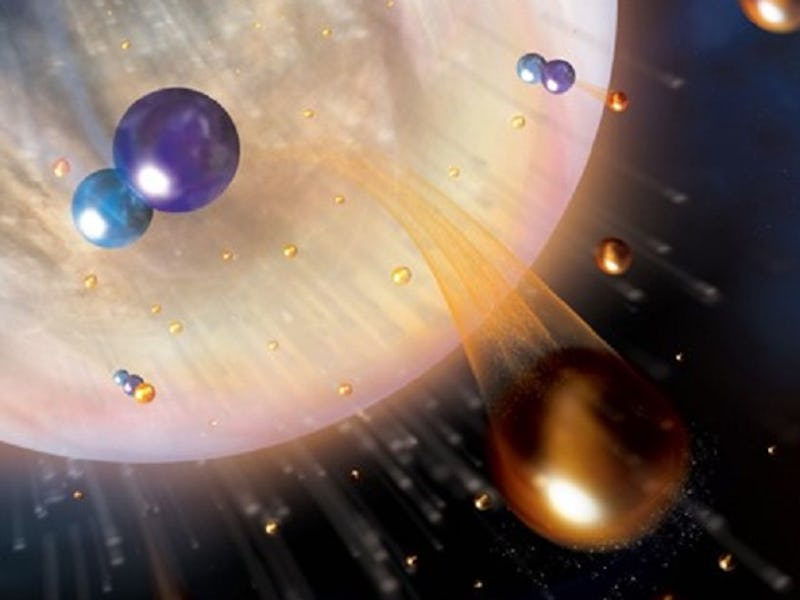A Simple Chemical Reaction May Have Wiped Out Venus's Once Watery Clouds
A recent study suggests that weird chemistry in Venus's upper atmosphere may explain why the once-steamy planet has so little water today.

A new model may shed light on what happened to the water that once covered Venus.
Venus used to be a lush, watery world like Earth, until a runaway greenhouse effect dried up its surface, leaving the planet shrouded by steamy clouds that used to be seas. Today, most of that steam is also gone, leaving behind sulfuric acid clouds that contain only microscopic traces of water. Learning exactly how Venus lost all its water could be the key to understanding how the planet became the hellscape it is today, and whether life, in some form, might have had a chance to adapt and survive in the airborne desert of the acid clouds.
University of Colorado, Boulder, planetary scientist Michael Chaffin, and his colleagues published their work in the journal Nature.
This illustration shows the chemical reaction that Chaffin and his colleagues say might have helped strip water out of Venus’s atmosphere. (Molecules are very definitely not to scale.)
Where Did All the Water Go?
Heat and solar wind play a major role in sweeping water away from Venus’s atmosphere, but the story is more complicated than that. There are other chemical ways for water molecules to break apart. Understanding those chemical processes, and how long they take to dry up the planet’s atmosphere, could be the key to understanding how long it took Venus to dry out and what’s happening on the planet’s surface today.
Using data from previous missions to Venus, Chaffin and his colleagues modeled the chemical reactions happening in the top hundred miles of Venus’s atmosphere: a region called the ionosphere, where electrically charged particles interact with solar wind (which is also made of charged particles). A big contributor, of course, is heat. Hot molecules move faster. Eventually, some move fast enough to escape the planet’s gravity and zoom into space. That’s a common problem for the atmospheres of planets that orbit in the inner reaches of their star systems because ultraviolet radiation from the star (our Sun, in this case) can heat atmospheric gas and aid its escape.
However, according to Chaffin and his colleagues’ computer simulations, those processes couldn’t remove water fast enough to produce the dry acid clouds shrouding Venus today. Thermal escape must have had help from other processes and the biggest culprit in Chaffin and his colleagues’ simulations was a chemical reaction between hydrogen and carbon monoxide.
It starts with a positively charged molecule of hydrogen and carbon monoxide, which quickly bonds with the first electron it bumps into, but that reaction triggers a dramatic breakup. A carbon monoxide molecule goes one way, and a hydrogen atom goes the other, flying fast enough to break free of Venus’s gravity and vanish into space. And since two-thirds of water is made of hydrogen, losing hydrogen makes it hard for water molecules to form. (In fact, some of the hydrogen that gets lost this way may originally have been part of a water molecule that got broken apart by ultraviolet radiation from the Sun.)
There are No Easy Answers on Venus
If Chaffin and his colleagues are right, this reaction, called HCO+ dissociative recombination could explain why there’s almost no water left in Venus’s atmosphere today. But there are some problems with the idea.
First, if there is indeed HCO+ dissociative recombination happening in Venus’s ionosphere as the models suggest, then there must be a fairly substantial amount of the stuff floating around up there. The problem is, no mission to Venus has ever seen any. According to Chaffin and his colleagues, that’s because the spectroscopes (instruments that measure the chemical composition of gas) on past missions, like Pioneer Venus (1978) and Venus Express (2005) weren’t sensitive enough to measure it. Upcoming missions like DAVINCI, EnVISION, and VERITAS may be able to tell whether they’re right.
Meanwhile, Chaffin and his colleagues' model still doesn’t quite solve one of the many mysteries about the skies of Venus. We know that compared to Earth, Venus has a surprisingly large amount of deuterium (an isotope of hydrogen with an extra neutron) than regular hydrogen. That happens because, when hydrogen gets heated and stripped away by solar wind, the lighter hydrogen atoms tend to go first, leaving behind more of the heavier deuterium. A planet’s ratio of deuterium to hydrogen can help tell the story of its history.
Both Earth and Venus still have much less deuterium than regular hydrogen, but the ratio of deuterium to hydrogen is higher on Venus. What we don’t know for sure is exactly how much higher that ratio is. Data from Venus Express puts it at around 240 times higher than Earth’s ratio, at least in the upper atmosphere. Space telescope observations have estimated somewhere between 15 and 40 times higher. Chaffin and his colleagues' simulations produce a model of Venus with a deuterium-to-hydrogen ratio right in the middle, about 110 times higher than Earth’s.
Because that ratio is so important in reconstructing the history of a planet’s water supply, future missions to Venus will need to get a better idea of those ratios. They’ll also need to find HCO+ in the planet’s upper atmosphere.